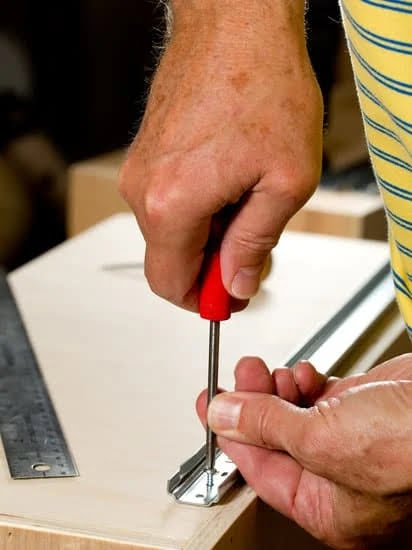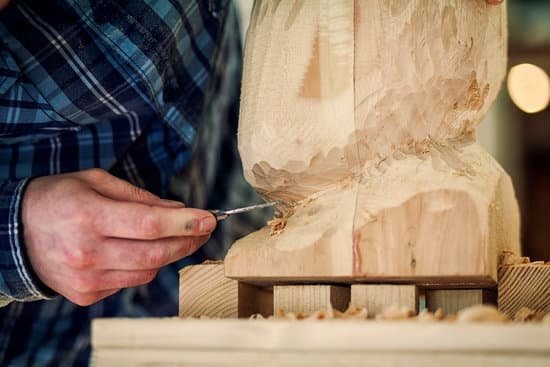Are you wondering how to store wood outside woodworking? Outdoor wood storage is a common challenge for woodworkers and DIY enthusiasts.
Whether you have a stockpile of lumber, firewood, or other types of wood, proper storage is crucial to maintaining its quality and usability. In this article, we’ll explore the best practices for storing wood outside, including understanding different types of wood and their storage needs, preparing wood for outdoor storage, choosing the right location, building a proper storage structure, protecting wood from the elements, regular maintenance and inspection, and creative ideas for organizing your outdoor wood storage.
Understanding the different types of wood and their unique storage needs is essential for successful outdoor wood storage. Seasoned hardwoods and softwoods each require specific conditions to prevent warping, rotting, and insect infestation. By learning about these requirements and implementing best practices, you can ensure that your stored wood remains in top condition.
In addition to understanding the specific needs of different types of wood, it’s important to properly prepare your wood for outdoor storage. This may involve sealing the ends of lumber to prevent excessive moisture loss or implementing other protective measures. Proper preparation can significantly extend the lifespan and usability of your stored wood. With these concepts in mind, let’s delve into the details of successful outdoor wood storage techniques.
Understanding the Different Types of Wood and Their Storage Needs
Wood storage needs vary depending on the type of wood being stored. Different types of wood have different characteristics and require specific storage conditions to maintain their quality and durability. It is essential to understand these variations to ensure proper outdoor wood storage.
When storing wood outside, it’s crucial to consider the following types of wood and their unique storage needs:
- Hardwoods: Hardwoods such as oak, maple, and cherry are known for their density and durability. They require a well-ventilated and dry storage area to prevent moisture buildup, which can lead to rot and decay.
- Softwoods: Softwoods like pine, cedar, and spruce are more susceptible to moisture damage. They require a covered storage area to protect them from rain and snow, as well as regular treatment with a water-repellent finish.
- Treated Wood: Treated woods, such as pressure-treated lumber, are infused with chemicals to resist rot and insect infestation. However, they still need protection from excessive moisture and direct sunlight to maintain their effectiveness.
Understanding the specific storage needs of different types of wood is essential for maintaining their quality when stored outside.
Properly preparing wood for outdoor storage is crucial in ensuring its longevity and usability. This involves not only choosing the right type of wood but also treating it appropriately before placing it in an outdoor storage area. Here are best practices for preparing wood for outdoor storage:
- Inspect the wood for any existing damage or signs of decay.
- Apply a water-repellent finish or sealant to protect the wood from moisture.
- Cover the ends of the boards with wax or end grain sealer to prevent splitting.
By following these best practices, you can ensure that your wood is adequately prepared for outdoor storage and will remain in excellent condition for future woodworking projects.
Best Practices for Preparing Wood for Outdoor Storage
When it comes to storing wood outside, proper preparation is key to ensuring that the wood remains in good condition. Whether you are storing lumber, firewood, or other types of wood materials, taking the time to prepare the wood before placing it outdoors can make a significant difference in its longevity and quality.
Properly Dry the Wood
One of the most important steps in preparing wood for outdoor storage is to ensure that it is properly dried. Wood that contains high levels of moisture is more susceptible to rot, mold, and insect infestations when stored outside. To dry the wood, it is best to stack it in a well-ventilated area with adequate airflow. Depending on the type and thickness of the wood, it may take several weeks or even months for it to dry completely.
Treat the Wood With Preservatives
To protect wood from decay and insect damage, consider treating it with preservatives before placing it outside. There are various types of wood preservatives available on the market, including paintable water-repellent preservatives and oil-based preservatives. Be sure to follow the manufacturer’s recommendations for applying the preservative and allow sufficient time for it to dry before storing the wood outdoors.
Seal the Ends of Boards
Another important step in preparing wood for outdoor storage is to seal the ends of boards. The end grain of lumber tends to absorb moisture more quickly than other parts of the wood, which can lead to splitting and warping. By sealing the ends of boards with a protective sealant or wax, you can help prevent moisture from entering and damaging the wood.
By following these best practices for preparing wood for outdoor storage, you can help ensure that your stored wood remains in good condition for future use. Properly dried, treated, and sealed wood will be better equipped to withstand exposure to the elements and maintain its structural integrity over time.
Choosing the Right Location for Storing Wood Outside
When it comes to storing wood outside, choosing the right location is crucial to ensure the longevity and quality of your wood. Here are some factors to consider when selecting the perfect spot for outdoor wood storage:
- Protection from direct sunlight: Exposure to direct sunlight can cause wood to dry, crack, and warp over time. Look for a shady area or consider using a tarp or cover to shield your wood from the sun’s rays.
- Proper drainage: It’s essential to choose a location with good drainage to prevent water from pooling around your stored wood. Standing water can lead to mold, mildew, and rot, so be sure to avoid low-lying areas or places prone to flooding.
- Air circulation: Adequate air circulation is necessary for preventing moisture buildup and promoting proper drying of the wood. Avoid placing your wood in tightly enclosed spaces or against solid surfaces that could restrict airflow.
- Distance from buildings and structures: When storing wood outside, it’s important to keep it at a safe distance from buildings, fences, and other structures. This helps minimize the risk of damage in case of fire and allows for better airflow around the stored wood.
By considering these factors when choosing the right location for outdoor wood storage, you can help protect your wood from potential damage and ensure its preservation for future woodworking projects.
Building a Proper Wood Storage Structure
When storing wood outside, it is crucial to have a proper storage structure in place to protect your wood from the elements and ensure its longevity. There are various options for building a storage structure, including sheds, lean-tos, or even simple racks and covers. The type of structure you choose will depend on the amount of wood you need to store, the available space, and your budget.
If you opt for a shed or lean-to, ensure that it is built with durable materials that can withstand outdoor conditions. This includes using pressure-treated lumber, metal roofing, and waterproofing sealants. Additionally, make sure the structure has good ventilation to prevent moisture buildup and discourage mold and mildew growth.
For those considering simpler storage solutions such as racks or covers, it is essential to make sure they are sturdy enough to support the weight of the wood and provide adequate protection from rain and snow. Consider elevating the wood off the ground using pallets or blocks to prevent moisture from seeping into the bottom layers.
Regardless of the type of structure you choose, it is important to regularly inspect and maintain it to ensure its effectiveness in protecting your wood. Check for any signs of damage or wear and tear, and make necessary repairs promptly. By investing in a well-built storage structure, you can effectively safeguard your wood from the elements and prolong its lifespan.
Overall, understanding how to build a proper wood storage structure is essential for successful outdoor wood storage. Whether you opt for a shed, lean-to, rack, or cover, prioritize durability and protection against the elements to keep your wood in optimal condition. By taking these steps, you can ensure that your outdoor wood storage is effective in preserving your valuable woodworking materials.
Tips for Protecting Wood From the Elements
When it comes to storing wood outside, protecting it from the elements is crucial in maintaining its quality and usability. Exposure to sun, rain, snow, and humidity can lead to warping, rotting, and other forms of damage. To prevent these issues, there are several tips for protecting wood from the elements.
One of the most effective ways to protect outdoor wood storage is by treating the wood with a weather-resistant sealant or stain. This will create a barrier against moisture and UV rays, helping to prolong the life of the wood. Additionally, covering the wood with a tarp or waterproof cover can provide an extra layer of protection from rain and snow.
Another important tip for protecting wood from the elements is proper ventilation. Good air circulation around the stored wood can help prevent mold and mildew growth, which can be damaging to the wood. Avoid stacking wood directly on the ground as this can lead to moisture absorption from the soil.
Lastly, regular inspection and maintenance are essential in protecting outdoor wood storage. Check for any signs of damage or deterioration on a routine basis and address any issues promptly. This can help catch any problems early on and prevent them from causing extensive damage to your stored wood.
By following these tips for protecting wood from the elements, you can ensure that your outdoor wood storage remains in good condition for future woodworking projects.
Regular Maintenance and Inspection of Outdoor Wood Storage
Once you have successfully prepared and built the proper wood storage structure, it is essential to regularly maintain and inspect the outdoor wood storage to ensure that the wood remains in good condition. Proper maintenance and inspection can help prevent damage from the elements and prolong the lifespan of your stored wood.
Regular Cleaning
Dirt, dust, and debris can accumulate on the surface of the stored wood, which can lead to deterioration over time. Regularly cleaning the wood with a soft brush or cloth can help remove these contaminants and prevent them from causing potential damage. Additionally, removing any standing water or snow buildup on top of the stored wood is crucial in preventing mold growth and rot.
Checking for Pests
One of the major threats to outdoor wood storage is pests such as termites, carpenter ants, and wood-boring beetles. Conducting regular inspections for any signs of pest infestation, such as small holes or sawdust-like frass, can help identify and address potential pest issues early on. If pests are detected, it is vital to take immediate action to eliminate them before they cause significant damage to your stored wood.
Inspecting for Signs of Deterioration
Periodically inspecting the condition of the stored wood is essential in identifying any signs of deterioration, including cracks, warping, or decay. Addressing these issues promptly by repairing or replacing damaged pieces can help maintain the overall quality of your stored wood. It is also important to regularly check for signs of moisture buildup or mold growth, especially in humid climates or during rainy seasons.
By following these regular maintenance and inspection practices, you can ensure that your outdoor wood storage remains in optimal condition and that your stored wood stays protected from potential harm caused by neglect or environmental factors.
Creative Ideas for Organizing and Storing Wood Outside
When it comes to storing wood outside, creativity is key to ensuring that your wood stays in good condition. One creative idea for organizing and storing wood outside is to utilize recycled or repurposed materials. For example, old pallets can be used to create a DIY wood storage rack or bin. This not only keeps your wood off the ground but also allows for proper air circulation to prevent moisture build-up.
Another creative solution for outdoor wood storage is utilizing vertical space. You can create a simple yet effective overhead storage system by installing sturdy hooks or brackets on an exterior wall or even under an overhang. This will keep your wood neatly organized and easily accessible while also maximizing the use of space in your outdoor area.
Additionally, consider implementing a modular storage system for your outdoor wood storage needs. Modular shelving units or stackable bins can be rearranged and customized to fit any outdoor space, allowing you to adapt the storage configuration as needed based on the amount and type of wood you have. This flexibility is especially useful for those who frequently work with different lengths and sizes of wood.
Overall, getting creative with outdoor wood storage not only ensures practicality but also adds an aesthetic element to your woodworking space. By using recycled materials, thinking vertically, and considering modular solutions, you can effectively organize and store your wood outside while maintaining its quality.
| Creative Storage Idea | Description |
|---|---|
| DIY Wood Storage Rack from Pallets | Repurpose old pallets to create a DIY rack for storing wood outdoors. |
| Vertical Overhead Storage System | Install hooks or brackets on an exterior wall for efficient vertical wood storage. |
| Modular Shelving Units | Create a customizable outdoor storage system using stackable bins or shelving units. |
Conclusion and Final Tips for Successful Outdoor Wood Storage
In conclusion, understanding how to store wood outside for woodworking is essential for maintaining the quality and longevity of your materials. By following the best practices outlined in this article, such as properly preparing the wood, choosing the right location, and building a proper storage structure, you can ensure that your wood remains in good condition and ready for use in your woodworking projects.
Regular maintenance and inspection of outdoor wood storage is also crucial in order to identify any potential issues early on and prevent damage to your materials. Additionally, implementing creative organization ideas for storing wood outside can help maximize space and keep your workspace tidy and efficient.
Remember to regularly protect your wood from the elements, such as using covers or sealants, to minimize potential damage from exposure to sun, rain, and snow. By prioritizing these practices, you can maintain the quality of your wood and ensure that it is ready for use whenever you need it. With careful attention to detail and consistent maintenance, outdoor wood storage can be both successful and rewarding for any woodworking enthusiast.
Frequently Asked Questions
Can You Store Untreated Wood Outside?
Untreated wood should not be stored outside because it is more susceptible to decay and insect infestation. Exposure to the elements can cause the wood to degrade more quickly, leading to a shorter lifespan.
How Do You Store Wood Outside Without Warping?
To store wood outside without warping, it’s important to keep it off the ground and allow for proper airflow. Stacking the wood on pallets or other supports can help prevent moisture from being trapped underneath, reducing the risk of warping.
Should I Cover Lumber With a Tarp?
It’s generally recommended to cover lumber with a tarp if it needs to be stored outside for a short period of time. This can provide some protection from moisture and UV exposure. However, for long-term storage, it’s best to invest in a dedicated storage solution such as a shed or covered area.

Hi everyone! I’m a woodworker and blogger, and this is my woodworking blog. In my blog, I share tips and tricks for woodworkers of all skill levels, as well as project ideas that you can try yourself.





